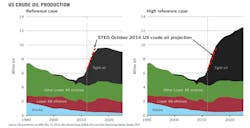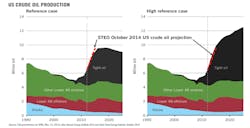The basic job for Oil & Gas Journal writers is to pick the right words and put them in the right order, which is often harder to do than it might sound.
In recent months, my assignment has been picking the words to best describe fluttering oil prices seemingly stuck on a downward trend.
The daily OGJ Online Market Watch stories have included phrases such as: ebb and flow, uncertain direction, seesaw, veer, waver, and vacillate.
I have yet to use the term "hem and haw" although I plan to experiment one day to see if "Analysts hemmed and hawed about plummeting oil prices…" makes it unscathed past Steven Poruban, managing editor-news.
But seriously, I am closely monitoring the consequences of falling oil prices on future tight oil investment and production.
Since 2008, the cumulative growth in US tight oil production has been 3.5 million b/d, which makes tight oil the key driver of global supply growth.
Daniel Yergin, IHS vice-chairman, told CNBC in November 2014 that he sees "a new era of world oil" defined by surging US oil production.
"Saudi Arabia is not driving the decline in oil prices as some suspect," Yergin said. "We have entered a new era of world oil."
New well investments
Jim Burkhard, IHS Energy vice-president, wrote a November 2014 blog about oil supply growth, noting the highest costs occur during a well's development.
"In the initial months of production, the oil price is critical to determine the profitability of a new tight oil well," Burkhard said.
Economics vary company-by-company, play-by-play, and even within a given play depending upon the sweet spots.
Roger Diwan, vice-president of IHS Financial Services, said the oil market is entering a new phase of deflationary pricing.
"Because of the rapid pace at which investments translate into production in the United States, the global market price is likely to bottom out only when the level of capital expenditures for US oil drilling show signs of slowing," Diwan said in a Jan. 27 IHS Unconventional Energy Blog.
"But with nearly half of new US oil production still economic at prices below $60[/bbl] as of 2014 levels-and with the huge momentum behind American oil production investment-this capital deceleration will not happen immediately," Diwan said.
Separately, Wood MacKenzie Ltd. estimates that if 2015 oil prices average $50/bbl, then the horizontal rig count for 2015 would fall 40% compared with 2014.
*Paula Dittrick is editor of OGJ's Unconventional Oil & Gas Report.

